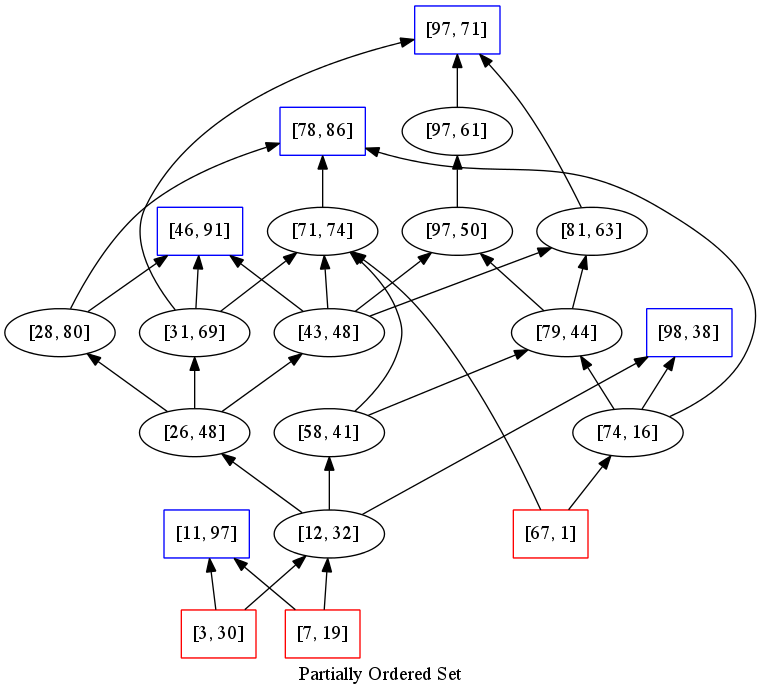POMAP - Partially Ordered Maps for OCaml
What is Pomap?
The Pomap library provides purely functional maps for partially ordered elements. These maps are like partially ordered sets but map values with a defined partial order relation to arbitrary other values. Here’s an example of a partially ordered set:

While total orders let you determine if an element is smaller, equal, or greater than another, partial orders introduce a “don’t know” or “undefined” case.
Mathematically, a partial order relation satisfies these axioms:
x <= x (reflexivity)
x <= y /\ y <= x -> x = y (antisymmetry)
x <= y /\ y <= z -> x <= z (transitivity)
Total orders, used in typical maps, also require:
x <= y \/ y <= x (totality)
Total orders align elements linearly (e.g., [1; 3; 7; 42]), while partial
orders are often represented by graphs, such as Hasse diagrams. Here’s another
example:
(89,73) (93,21)
|
(91,38) (57,42)
| / |
| / |
(44,26) (25,42)
\ /
(22,23)
In this structure, pairs of integers are elements. A pair is larger if both integers are larger than those in another pair. If both are smaller, the pair is smaller. If pairs have equal elements, they are equal. If neither condition holds, the order is “unknown” (e.g., pairs (44,26) and (25,42)).
Lines show order: the greater element appears above the smaller one. Hasse diagrams omit lines implied by transitivity. For example, there’s no line between (89,73) and (25,42). If elements are unreachable without reversing direction, they are incomparable (e.g., (93,21) is incomparable to others).
Internally, the library represents relations similarly to Hasse diagrams, enabling easy reasoning and quick manipulation.
Application Areas
Data Mining
Concept lattices, which have a similar structure as partial orders, can be managed with this library. For instance, an e-commerce site could use it to identify frequently bought product baskets.
Databases
Partial order structures can optimize database queries on multi-valued attributes by improving indexing.
Advantages of This Library
Referential Transparency
Functions handle data structures purely functionally, allowing more than one version in memory with structure sharing. This makes reverting changes efficient and safe for multi-threaded environments.
Incremental Updates
Unlike algorithms that generate Hasse diagrams in batches, this library supports efficient incremental updates, adding or removing elements as needed.
Efficiency
Time and memory consumption are suitable for practical problems. Building a Hasse diagram for 1000 elements of moderate complexity typically takes less than a second on modern machines.
Usage
API Documentation
Refer to the API documentation for programming reference, built during
installation with make doc. The API documentation is also available
online.
Specifying the Partial Order Relation
Provide a function that computes the partial order relation between two
elements. See the PARTIAL_ORDER signature in lib/pomap_intf.ml:
module type PARTIAL_ORDER = sig
type el
type ord = Unknown | Lower | Equal | Greater
val compare : el -> el -> ord
end
Specify the element type and a comparison function returning Unknown if
elements are incomparable, Lower if the first is lower, Equal if equal,
and Greater if the first is greater. Example implementations are in
examples/hasse/po_examples.ml.
Creating and Using Partially Ordered Maps
With a partial order relation specification, e.g., MyPO, create a map:
module MyPOMap = Pomap_impl.Make(MyPO)
The POMAP interface in lib/pomap_intf.ml defines functions for partially
ordered maps. Nodes store information, accessible by key, data element,
successor indices, and predecessor indices. The system generates fresh indices
for new nodes.
Accessors for bottommost and topmost node indices allow for navigation in the Hasse diagram.
Rendering Hasse Diagrams
The library includes modules for rendering Hasse diagrams using pretty-printing
functions. This requires the Graphviz package and
its dot utility. The hasse example demonstrates usage and includes a README.
Contact Information and Contributing
Submit bug reports, feature requests, or contributions to the GitHub issue tracker.
Find up-to-date information at: https://mmottl.github.io/pomap